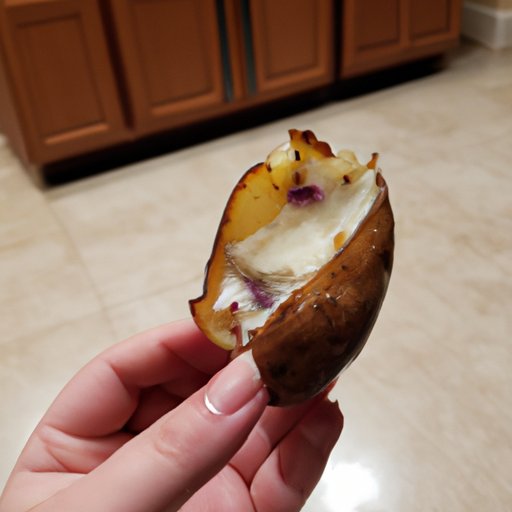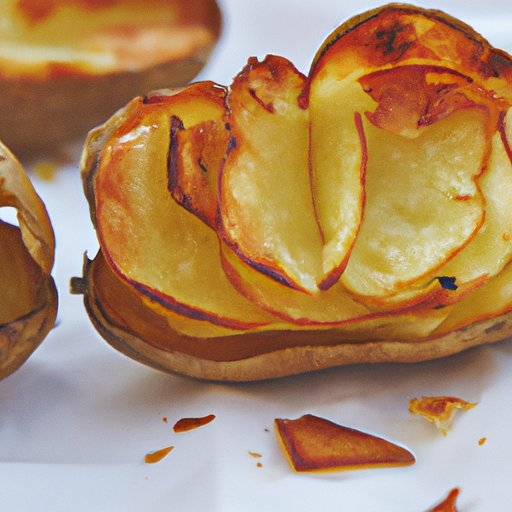Introduction
Potato skins have long been a favorite snack food, often served as an appetizer in restaurants or as a side dish at home. But what exactly are potato skins, and are they good for you? Potato skins are simply the outer layer of a potato, including the skin and some of the underlying flesh. They are typically deep-fried or baked and then topped with cheese, bacon, sour cream, and other ingredients. While potato skins can be tasty and convenient, it’s important to understand their nutritional profile and potential health risks before deciding whether or not to include them in your diet.

Nutritional Benefits of Eating Potato Skins
Potato skins may not be the most nutrient-dense food, but they do offer some key nutritional benefits. One medium-sized potato skin contains about 110 calories, 8 grams of fat, 2 grams of protein, and 3 grams of fiber. That same potato skin also provides 10% of the recommended daily value (DV) for vitamin C, 6% of the DV for iron, and 4% of the DV for potassium.
One of the biggest benefits of potato skins is their high fiber content. Fiber helps promote regularity, support digestive health, and control blood sugar levels. A study published in the Nutrition Journal found that adults who consumed more dietary fiber had lower body mass index (BMI) and waist circumference than those who consumed less fiber.

Exploring the Health Risks of Eating Potato Skins
The main downside to eating potato skins is their high calorie and fat content. The average potato skin contains around 110 calories and 8 grams of fat, mostly from saturated fat. Eating too many potato skins can add extra calories and fat to your diet, which can lead to weight gain and other health issues.
Another potential health risk associated with eating potato skins is the formation of acrylamide. Acrylamide is a chemical compound formed when starchy foods like potatoes are cooked at high temperatures. Studies have linked acrylamide consumption to an increased risk of cancer, though the exact amount of acrylamide needed to cause harm is still unclear.
The Pros and Cons of Eating Potato Skins
When it comes to deciding whether or not to eat potato skins, there are both pros and cons to consider. On the plus side, potato skins are relatively nutritious and provide a decent amount of fiber, vitamins, and minerals. They’re also easy to find and prepare, making them a convenient snack or side dish.
On the downside, potato skins are high in calories and fat, and they can contain significant amounts of acrylamide. Eating too many potato skins can lead to weight gain and potentially increase your risk of certain diseases.

What the Science Says About Eating Potato Skins
Though there’s no definitive answer to the question of whether or not potato skins are good for you, research suggests that they can be enjoyed in moderation. Several studies have shown that eating potatoes, including potato skins, can provide a variety of health benefits, including improved blood sugar control and a reduced risk of cardiovascular disease.
At the same time, other studies have linked the consumption of acrylamide-containing foods to an increased risk of cancer. The American Cancer Society recommends limiting the amount of fried and high-temperature cooked foods in your diet, including potato skins, to reduce your risk of developing cancer.
Creative Ways to Make Healthy Potato Skins
If you’re looking for ways to enjoy potato skins without compromising your health, there are plenty of creative ways to make them healthier. For starters, try baking your potato skins instead of frying them. Baking not only cuts down on the fat and calories, but it also reduces the amount of acrylamide formed during cooking.
You can also opt for low-fat toppings like Greek yogurt or salsa, and add veggies like bell peppers or spinach. Finally, don’t be afraid to get creative with herbs and spices. Adding garlic powder, paprika, or dried herbs can give your potato skins a delicious flavor without adding extra calories.
Conclusion
Potato skins can be a tasty and convenient snack or side dish, but it’s important to understand the potential health benefits and risks associated with eating them. Potato skins are high in calories and fat, and they can contain significant amounts of acrylamide. However, if eaten in moderation and prepared in a healthy way, they can provide a variety of nutritional benefits.
Overall, the decision to eat potato skins is a personal one. If you’re looking to enjoy them in a healthier way, try baking them instead of frying and topping with low-fat ingredients and fresh veggies. With a few simple tweaks, you can enjoy potato skins without compromising your health.
(Note: Is this article not meeting your expectations? Do you have knowledge or insights to share? Unlock new opportunities and expand your reach by joining our authors team. Click Registration to join us and share your expertise with our readers.)
